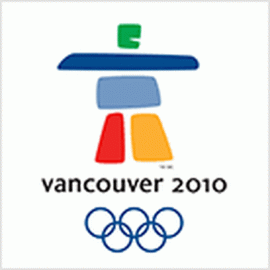“Ilanaaq” is the name of the well-known logo of the 2010 Vancouver Winter Olympic Games. This logo, based on the Inuit inuksuk (also spelled inukshuk), consisted of a multi-coloured, five-piece design created by Elana Rivera MacGregor of the Rivera Design Group in Vancouver.
This was the winning design in the competition for the emblem for the 2010 Olympics that drew over 1,600 entries.
One might wonder why the design was based on the inuksuk, a symbol from the North, with cultural ties to a very small portion of Canada’s population. I am a fourth-generation Canadian of European descent, and while I proudly proclaim myself to be Canadian, I find that I have very shallow cultural roots. As a nation, Canada is lacking in cultural commonalities that encompass the broad and varied multicultural make-up of this country. While different regions of Canada and many cultural groups within Canada have traditions and customs of their own, there are few overarching symbols—apart from the iconic maple leaf (which, ironically, comes from a very regional tree)—that connect the diverse cultures and regions that combine to make Canada, well… Canadian. So when an event such as the Olympics needs an emblem that will represent Canada, a natural place to look is within the rich cultures of Canada’s original societies. In fact, the designer of the logo stated that she felt that it was important that there be a cultural component in the design of the 2010 Olympic logo. The inuksuk is iconic, a strong symbol that all Canadians can be proud of. From a graphic designer’s point of view, it is unique, has strong lines, and draws the eye. And it is a highly marketable commodity.
This is not the first time that the inuksuk has been used to represent Canada—according to Wikipedia, there are inuksuit (plural form of inuksuk) that have been donated wholly or in part by the Canadian Government in Brisbane (Australia), Monterrey (Mexico), Oslo (Norway), Washington, DC (USA) and Guatemala City (Guatemala); replica inuksuit are sold across Canada as souvenirs, and hand-built miniature inuksuit are sold as works of art. The 2010 Vancouver Olympics was, however, arguably the broadest commercial use to date.
When you look at an old inuksuk you are seeing more than a stack of stones. You are seeing the thoughts of another person left on the land — Norman Hallenday (in Mary Wallace's The Inuksuk Book).
The Significance and Impact of this Cultural Appropriation
The use of the inuksuk by the 2010 Olympic Committee as the logo/emblem for the games is an appropriation (see the Oxford Dictionary definition). The logo is a stylized inunnguag (an inuksuk with arms, legs, and a head). While there are clear issues of commercial use benefitting groups outside of the culture that created the inuksuk, as well as complexities associated with copyright and trademark law, the question that I explore here is the use of the inuksuk in the context of a cultural appropriation, and the issues that can arise when an important cultural symbol is used, defined and described outside of cultural context from which it arose.
Cultural appropriation is defined as: "…the adoption of some specific elements of one culture by a different cultural group. It describes acculturation or assimilation, but can imply a negative view towards acculturation from a minority culture by a dominant culture. It can include the introduction of forms of dress or personal adornment, music and art, religion, language, or social behavior. These elements, once removed from their indigenous cultural contexts, can take on meanings that are significantly divergent from, or merely less nuanced than, those they originally held" (emphasis added) (Babylon Dictionary).
The use of an emblem based on the inuksuk by the 2010 Olympics has led to the distribution of information, definitions, and meanings that are divergent from the meanings and uses originally associated with inuksuit. While these definitions and meanings are based on information that has some accuracy, the interpretations of the meaning of the inuksuk from outside the culture have resulted in an interpretation that is “significantly divergent from” and “less nuanced” than the original meanings. For example, while “Ilanaaq” is referred to as an inuksuk, the emblem is actually an inunnguag (an inuksuk with arms, legs, and a head). Peter Irniq, Inuit cultural activist, inuksuit builder, and former Nunavut commissioner, stated that the emblem should not be called an inuksuk as this type of design (the inunnguag) has only been built in the last hundred years or so, largely by non-Inuit people, and these structures are not true inuksuit. Yet, the logo is consistently referred to as an inuksuk, not as an inunnguag.
A look at the meanings and cultural significance and use of the inuksuk within Inuit culture, when compared to the meaning associated with “Ilanaaq” demonstrates significant divergence from the traditional meanings. By way of example, these divergences in meaning and nuanced changes to the meaning are demonstrated through two Youtube videos, “What is an Inukshuk?,” by Positive NRG.nl with commentary by Peter Irniq, and “The Inukshuk,” created by the Vancouver Film School in 2008. Mr. Irniq discusses the history and importance of inuksuit—that they were, and are, constructed for survival. Traditionally, inuksuit are land markers, showing places where the hunting and fishing is good, marking the way for travellers, indicating where Inuit have lived, and marking where caches of food have been stored. They all had meaning and specific purposes, and were not to be built indiscriminately. The Vancouver Film School video, on the other hand, containing some information that is accurate, as well as some that is not, concludes that inuksuit mean “friendship.” In an article published in the Vancouver Sun in February 2010, Ellen Rivera MacGregor, the designer of the Olympic logo and author of the article, stated: "The Inukshuk conveys our basic human warmth and friendliness as Canadians and provides a fantastic symbol for the Friendship Games, not only for the visitors who will be arriving, but also to remind us of the values that make Canada a truly great place to live.…If visitors ask you what the Inukshuk is, simply tell them it represents Canadian friendship, the heart of our country."
While Ms. Rivera MacGregor appears to have based her conclusion on characteristics she associated with the inuksuk including community, safety, hope, cooperation and friendship, which are not entirely inaccurate, her interpretation of those characteristics diverges significantly from Mr. Irniq’s explanation of survival, and serves to diminish the importance of inuksuit to the Inuit. “Friendship,” while not diametrically opposed to “survival”, is certainly a considerable interpretive leap. Jackie Thompson, in criticism of Ms. Rivera Macgregor’s interpretation of the meaning of the symbol, states: "… implying that the Inushuk is merely a symbol of 'Canadian friendliness' eliminates the true meaning and story and tradition behind it."
In comparison, Robin R.R. Gray, in her 2013 article "Appropriation (?) of the Month: First Nation Totem Poles,” discussed the appropriation of First Nation totem poles, and the consequences of defining the meaning of totem poles from outside the culture that created totem poles: "Even though totem poles are defined by the First Nations peoples who create them as communicators of Indigenous knowledge, events, history, place, rights, laws and identity, non-Indigenous peoples have long superimposed their own ways of knowing, being and doing onto totem poles, thereby redefining totem poles on non-Indigenous terms. This redefinition has essentially robbed First Nation totem poles of their meaning by taking them, using their image and talking about them, out of their cultural contexts."
Apart from the innate commercial unfairness and trademark and copyright issues, the more subtle and often overlooked danger of uses that are inconsistent with traditional uses is that the meaning, importance and significance of inuksuit become diluted. Scott Heyes, in a 2002 article, commented that: "The increased attention inuksuit receive through marketing is not necessarily adverse, but the way they are portrayed and displaced outside the arctic context may distort their traditional function."
The traditional stories and knowledge associated with the inuksuk do not appear to be included in the contemporary interpretations that flowed from the 2010 Vancouver Olympics, and the critical traditional role that the inuksuk plays in the North is minimized. While there is nothing wrong with the concept of “friendship,” the inuksuk represents so much more. Peter Irnaq, with specific reference to inuksuit, succinctly summarizes the importance of an accurate portrayal of symbols of a culture, and the dangers created by a dilution or trivialization of the meanings associated with items of cultural heritage: "When our culture is interpreted the right way, we are stronger and have more pride. Teaching our children and our grandchildren the accurate way will allow them to have strength for their future, from their past."
A further issue in this matter is that of an opportunity missed. Through the adoption and promotion of an interpretation that was simplistic, the more complex, accurate meanings associated with inuksuit were overshadowed. Eight years before the 2010 Olympics, Scott Heyes considered the potential consequences of mass production and commercialization of inuksuit, and concluded on an optimistic note: "Legislation cannot protect inuksuit from ongoing tourism marketing campaigns, but public awareness of their importance to the Inuit may reduce their fate of becoming exclusively a garden folly or collectable trinket. With the increased attention paid to inuksuit, one may speculate that the rebirth of inuksuit stories and songs may be imminent."
As Canadians, we have missed the boat. The use of “Ilanaaq” as the logo for the 2010 Games was a golden opportunity to explore and share with the world the richness and complexity of the inuksuk and its relationship with the Inuit culture. To reduce the story of the inuksuk to that of “friendship” ignored and diminished the importance of this incredible symbol, and distorted and over-simplified a complex and important story. Only time will tell if the exposure gained through the 2010 Vancouver Olympics will contribute to the rebirth of the stories and songs associated with the inuksuk to which Heyes refers, or to the dilution and diminishment of the rich culture associated with these symbols that are such an important part of the Inuit culture.
Sources & Recommended Readings
CBC News. 2005. Vancouver Emblem Comes Under Fire.
Ford, Violet. 2013. Commodification of Inuit Symbols and Potential Protection Mechanisms. IPinCH Cultural Commodification, Indigenous Peoples & Self-Determination Public Symposium. Vancouver, May.
Gray, Robin R. R. 2013. Appropriation (?) of the Month: First Nation Totem Poles.
Heyes, Scott. 2002. Protecting the Authenticity and Integrity of Inuksuit Within the Arctic Milieu, Études/Inuit/Studies 26(2): 133-156.
Hallenday, Norman. 1999. "Introduction" in The Inuksuk Book, edited by Mary Wallace. Maple Tree Press, Inc, Toronto.
Inuit Tapiriit Kanatami. ND. The People Behind The Inukshuk.
Irniq, Peter. 2006. “Letter to the Editor: The Ancestral Inuksuk.” Naniiliqpita, Nunavut Tunngavik Incorporated.
Positive NRG.nl. 2007. “What is an Inukshuk?” (interview with Peter Irniq).
Roth, Solen. 2013. Cultural Modified Capitalism: The Native Northwest Coast Artware Industry. PhD, University of British Columbia, Department of Anthropology.
MacGregor, Elena Rivera. 2010. Why the Inukshuk represents the heart of Canada. Vancouver Sun.
Thompson, Jackie. 2013. “The Inukshuk - True Representation of Canadian Identity?”
Vancouver Film School. 2008. The Inukshuk.
Wallace, Mary. 1999. The Inuksuk Book. Maple Tree Press, Inc., Toronto.
Wikipedia. Inuksuk.
Laura Skorodenski works with Kutz Olson Law, and is an IPinCH Associate.
Our Appropriation (?) of the Month features, written by IPinCH team members, highlight the complexity of 'cultural appropriation' and 'cultural appreciation'.







Comments
Promising Title, Disappointing Read